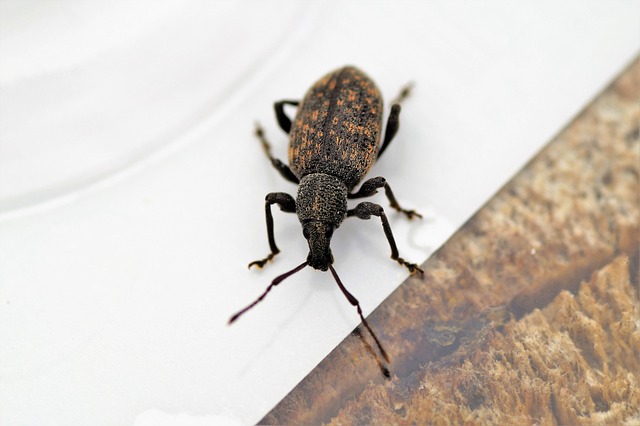Stinging pests like wasps, bees, and hornets pose a common problem, especially in warmer seasons. Regular inspections and identifying nesting areas are vital for effective stinging pest control services. Professionals use advanced tools and expertise to locate nests, offering tailored strategies for professional wasp removal, bee and hornet control, and stinging insect extermination across residential and commercial settings. These services prioritize safety, humane methods, and comprehensive protection against these insects.
In the realm of pest control, stinging pests like bees, wasps, and hornets pose a unique challenge. Their intricate nests, often hidden, can lead to severe reactions if disturbed. Understanding these insects’ behavior is crucial for effective management. Regular inspections are key to identifying nesting areas before they become problematic, especially in residential and commercial spaces. This article explores various methods to pinpoint these hiding places and highlights the benefits of professional stinging pest removal services, offering a comprehensive guide to tackling this dilemma.
Understanding Stinging Pests: Types and Behavior
Stinging pests, such as wasps, bees, and hornets, are a common nuisance, especially during warmer months. Understanding their behavior is crucial for effective stinging pest control services. These insects build nests in various locations, from trees and shrubs to attics and walls of residential properties, or even in commercial buildings. Wasps, for instance, are known for their paper-like nests, while bees often construct honeycombs inside hives. Identifying these nesting areas is the first step towards professional wasp removal, bee and hornet control, and stinging insect extermination.
Different species have distinct behaviors, which can impact the best approach for pest control for stinging insects. Some are aggressive and will defend their nests vigorously, while others are more docile. Knowing whether a nest contains bees or wasps is vital as it determines the safety of residential stinging pest services and commercial stinging pest removal processes. For example, bee colonies typically require specialized handling to prevent colony destruction and ensure the safety of nearby residents and workers. Effective pest control for stinging insects necessitates a thorough understanding of these behaviors and the species present in a given area.
The Importance of Regular Inspections for Stinging Pest Control
Regular inspections are a cornerstone in effective stinging pest control. These meticulous assessments allow professionals to identify potential nesting areas, often hidden or hard-to-reach, before they become problematic. By proactively locating and treating nests, services like professional wasp removal, bee and hornet control, and stinging insect extermination can significantly reduce risks associated with stinging pests. This is especially crucial for residential and commercial properties, where these insects can cause not only discomfort but also severe allergic reactions.
Pest control for stinging insects is not just about eliminating existing colonies; it’s a proactive measure to prevent future infestations. Regular inspections enable specialists to develop tailored strategies, ensuring that each property receives the most effective and efficient treatment for pest control services. This comprehensive approach not only protects folks from unwelcome stings but also fosters a safer, more enjoyable living or working environment.
Effective Methods to Identify Nesting Areas
Effective methods to identify nesting areas involve a combination of visual inspection and expert knowledge. Professional wasp removal specialists utilize their extensive training to locate subtle signs that indicate the presence of stinging pest nests. These can range from small entry points in walls or roofs to piles of chewed wood or other materials, which often serve as indicators for bee and hornet control.
In addition to visual cues, these experts employ advanced tools like thermal imaging cameras and listening devices to pinpoint the exact locations of nests. This meticulous approach ensures comprehensive pest control for stinging insects, whether it’s in a residential setting where stinging insect extermination is required or in commercial spaces that demand specialized services for handling stinging pests.
Professional Stinging Pest Removal Services: A Comprehensive Guide
When dealing with stinging pests like wasps, bees, and hornets, it’s crucial to turn to professional stinging pest control services for comprehensive solutions. These experts are trained to identify nesting areas, often hidden or challenging to access, using advanced techniques and tools. They employ safe and effective methods tailored to specific insect types, ensuring minimal environmental impact while swiftly eliminating the threat.
Professional wasp removal, bee and hornet control, and stinging insect extermination require specialized knowledge and equipment. Residential stinging pest services cater to homeowners concerned about safety and property damage. Commercial stinging pest removal focuses on businesses facing similar challenges due to busy activity areas or large structures. Regardless of the setting, professional services offer peace of mind, ensuring these pests are managed humanely and effectively.
Thorough inspections are key to effective stinging pest control. By understanding the behavior of types like bees, wasps, and hornets, and employing methods to identify their nesting areas, both residential and commercial properties can mitigate risks. While DIY methods have their place, professional wasp removal and bee and hornet control services offer specialized knowledge and equipment for complex cases. Integrating regular inspections with expert stinging insect extermination ensures a safe, pest-free environment. For those seeking comprehensive solutions, professional stinging pest control services are indispensable in managing these persistent intruders.
